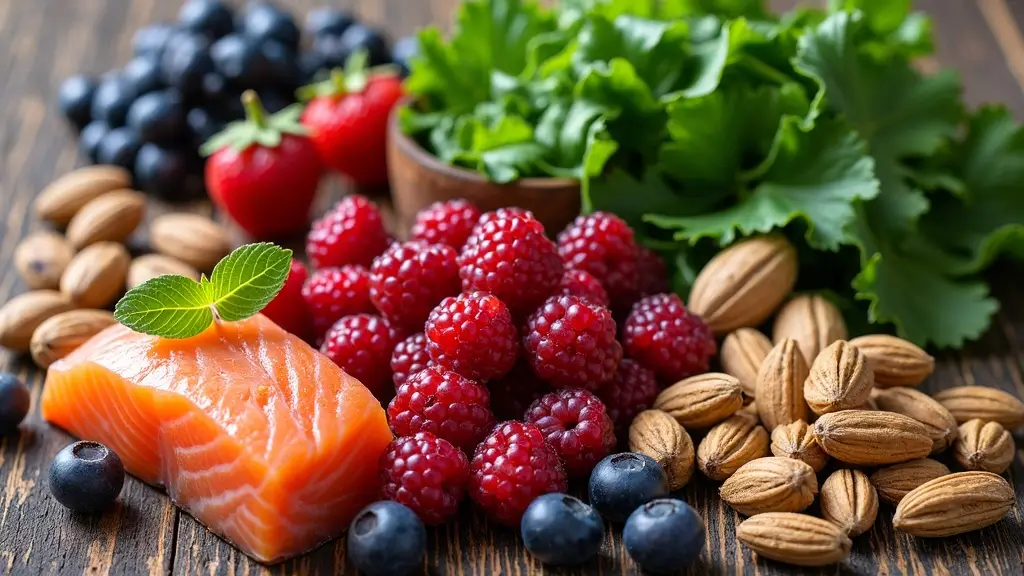Adding superfoods to my daily meals can really change the way I feel and support my health over time. These foods are known for their rich mix of vitamins, minerals, and antioxidants. There’s a lot of information (and sometimes hype) out there, so I’m going to break down what superfoods are, why they matter, how to make the most of them, and where a little caution is wise.

What Are Superfoods and Why Do They Matter?
The term “superfood” gets used a lot, but there’s actually no official legal or nutritional definition for it. In general, superfoods are mostly plant based foods that contain unusually high amounts of nutrients. This includes antioxidants, vitamins, minerals, healthy fats, or sometimes protein. Antioxidants are really important because they help my body fight off free radicals. Unstable molecules are linked to a higher risk for several diseases like heart disease, cancer, stroke, arthritis, and Parkinson’s disease. Eating superfoods as part of a broader healthy diet may help reduce risks over time.
Superfoods are not cure all foods. No single ingredient can replace the need for a balanced and varied diet, but including more nutrient dense choices can help tip the scales in a positive direction for health.
Spotlight on Some Common Superfoods
There are plenty of foods that fall into the superfood category thanks to their nutritional value and health research. Here are a few that really stand out for me:
- Berries: Acai berries have amino acids, healthy fats, and lots of antioxidants. Blueberries deliver fiber, vitamin K, and manganese. Cranberries are known for helping prevent urinary tract infections. Goji berries provide vitamin C, vitamin E, and flavonoids, and have a long history in traditional Chinese medicine.
- Tea: Both green and white teas are loaded with catechins, which are powerful antioxidants. Drinking them might help with stress reduction and inflammation, and some studies suggest possible benefits for arthritis.
- Leafy Greens: Foods like kale, spinach, Swiss chard, beet greens, and collard greens are loaded with vitamins A, C, E, and K, carotenoids, and minerals. Their fiber content is a bonus for digestion.
- Salmon and Fatty Fish: Oily fish like salmon, sardines, and mackerel are high in omega 3 fatty acids. These kinds of healthy fats are linked with lower risks of heart disease, help keep cholesterol in check, and support smoother blood flow.
- Dark Chocolate: Quality dark chocolate (with high cocoa content) contains flavonoids, which can help protect against heart disease and support the immune system. I watch out for added sugars to make sure I get the benefit from the actual cacao.
- Wine & Grapes: Grapes include antioxidants like resveratrol and quercetin. There’s talk about wine offering these benefits, but whole grapes come with fiber and are a safer bet nutritionally.
- Other Superfoods: Honorable mentions go to spirulina, bluegreen algae, garlic, wheatgrass, beets, turmeric, Brazil nuts, and barley. Each brings its unique nutrient mix and health perks.
How Superfoods Fit Into Everyday Eating
In my experience, healthy eating isn’t about turning every meal into a “superfood bowl.” Instead, it helps to think of building a “super diet” where colorful, whole foods replace processed and packaged items as much as possible. Any fruit or vegetable can function as a superfood when it’s fresh, in season, and part of a balanced meal. Local and seasonal produce often packs more flavor and nutrition as well.
Swapping in more whole foods almost always leads to better health outcomes. This is especially true if I keep meals colorful and varied. In recent months, I’ve found that branching out with different nuts and seeds like pumpkin seeds, sunflower seeds, or walnuts gives my meals new flavors and textures. These additions are easy and add healthy fats and minerals, plus they keep things interesting at snack time or sprinkled over salads.
Small Changes That Make a Big Difference
- Add more color with kale, berries, beets, and brightly colored veggies.
- Toss greens into soups, omelets, or stir fries for a quick nutrient boost.
- Trade out an extra serving of red meat for salmon or tofu in a couple of meals per week.
- Add berries or seeds to oatmeal, yogurt, or salads to easily up the nutrition.
- Include some type of fruit or vegetable at every meal, even breakfast.
- Drink a cup of green or matcha tea instead of sugary drinks or extra coffee.
- Cook more often with spices such as turmeric, ginger, or cinnamon for bonus antioxidants.
- Snack on unsalted nuts, seeds, or dried fruits instead of chips or sweets.
- Try new superfoods by rotating what you buy at the store. For example, switch up the fruit you eat each week, or cook with a different whole grain like quinoa, barley, or farro to get a wider nutrient range.
Risks and Limitations of Superfoods
Even with all these upsides, there are a few things I have to keep in mind. Superfood supplements or powders are not the same as eating real, whole foods. Some supplements may actually cause strong effects, interact with medications, or even lead to toxicity if taken in high doses. For example, too much vitamin E or vitamin K can cause issues with bleeding or interfere with certain medications, and even “all natural” pills can have hidden risks. Post surgical complications are sometimes linked to high supplement use too.
Focusing too much on a single “hero” food can also mean missing out on the balance and synergy that comes from eating a variety of mostly unprocessed foods. The body generally does better when it gets nutrients from diverse sources, not just one concentrated powder or pill. Even when grocery shopping, I remind myself to bring home a rainbow of fruits and vegetables rather than buying bags of just one thing.
How to Use Supplements Safely (If You Do)
- Check information from trusted sources like the NIH or FDA before buying anything.
- Stay skeptical of wild marketing claims about “miracle” results.
- Remember that “natural” doesn’t always mean “safe.”
- Go for brands that offer third party testing or certification whenever possible.
- Talk to a healthcare provider before starting any new supplement, especially if I’m on medication or have a health condition.
Practical Tips to Get the Most From Superfoods
I’ve found that the key to making superfoods work in my life is keeping it simple and consistent. Trying to find a new superfood every week can be expensive and exhausting. Instead, I stick to options I know I like and that fit my healthy lifestyle. For example, tossing a handful of spinach into scrambled eggs gives me more protein and iron without much effort. Roasting a tray of carrots, beets, and broccoli is a goto for meal prep. Choosing fatty fish once or twice a week gives me those healthy omega 3s with meals I enjoy.
Balanced meal planning and prepping on weekends can help. I’ll keep frozen berries on hand for smoothies or oatmeal and prechop veggies for fast stir fries and soups. The right habits have helped me squeeze more superfoods into my day without stressing over it. Cooking at home gives me more control over ingredients and lets me experiment with dishes, like grain bowls topped with seeds and chopped greens, or soups made from seasonal root vegetables.
Frequently Asked Questions
Over time, I’ve come across certain questions about superfoods that pop up again and again. Here are a few that stand out:
What’s the difference between a superfood and a regular healthy food?
Superfoods don’t have any official definition, but they tend to have higher concentrations of nutrients or antioxidants compared to ordinary foods. That said, almost any fruit or vegetable can be considered a superfood if it’s eaten regularly and in the right balance. I try to focus on variety by including options from every color in the produce section.
Should I take superfood powders or supplements?
Whole foods give the best health benefits in most cases. Supplements can be useful if I have gaps in my diet, but they aren’t needed for everyone and can cause issues if overused. If I’m thinking about a supplement, I check with my healthcare provider first. In my own routine, whole foods are easier to enjoy and less likely to cause surprises.
Can I eat too many superfoods?
Balance is always the key. Eating superfoods as part of a varied diet is healthy, but focusing on a single food, for example, tons of kale or a giant bag of goji berries every day, can throw my body off balance, too. Moderation and variety help the most. I pay attention to how different foods make me feel, and I look up serving sizes if I’m unsure.
Do kids and older adults benefit from superfoods too?
Absolutely. Kids, teens, and seniors can all benefit from nutrient dense foods/ingredients, especially when these come from simple, whole food sources like berries, nuts, veggies, and fish. I keep in mind that it’s important to account for allergies, portion sizes, and any specific health conditions when serving superfoods in my family meals. Sometimes I’ll blend fruit into smoothies for kids, or offer plain Greek yogurt topped with fruit and nuts as a snack for older relatives.
Bringing It All Together
In my own routine, focusing on a variety of superfoods helps me feel more energetic, boosts my mood, and supports my overall health. The main point is to enjoy whole, nutrient dense foods as part of a balanced eating pattern. There’s no need to hunt for rare or expensive ingredients. Even basic everyday produce, like apples, carrots, spinach, or plain yogurt, counts toward a “super diet” when I enjoy them often. With a few simple adjustments and smart choices, anyone can bring more superfoods into their kitchen. Grocery shopping becomes a chance to try new produce, or make easy swaps like choosing whole grains instead of white rice, or adding beans into soups and salads. Eating superfoods is not about strict rules but about small, satisfying upgrades that, over time, make a real difference for health and enjoyment.
